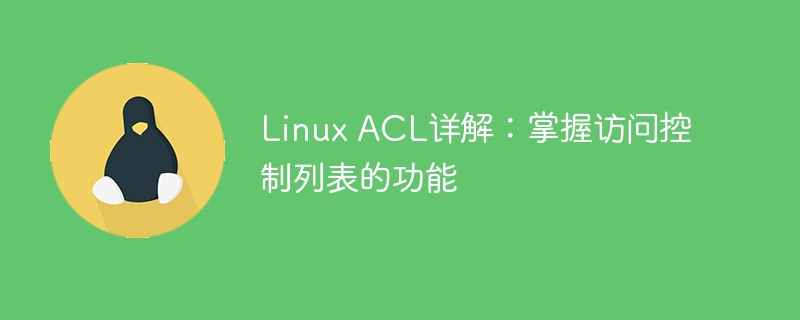

Linux ACL Detailed explanation: To master the function of access control list, specific code examples are needed
In Linux system, ACL (Access Control List) is a management An important mechanism for file and directory access permissions. The traditional Linux permission system only has simple rwx permissions and cannot control the access permissions of different users to files and directories in detail. ACL provides a more flexible and refined permission control method, allowing administrators to set different permissions for different users and groups.
1. The basic concept of ACL
ACL is actually a kind of permission information stored in the form of a list. Each file or directory can have its own ACL, which records the users who access this file or directory. or group permission information. ACL can control read, write, execute and other permissions, and inheritance rules can be set to achieve more refined permission management.
2. Basic ACL operations
View ACL
Use the command getfacl to view the ACL information of the specified file or directory, for example:
getfacl test_dir
This command will display the ACL information of the test_dir directory.
Set ACL
Use the command setfacl to set the ACL information of a file or directory. The syntax is as follows:
setfacl -m u:user:permissions file
where u represents the user , user represents a specific user, and permissions represents permission settings. For example, set user1 to have read and write permissions on test_file:
setfacl -m u:user1:rw test_file
After the setting is completed, you can use getfacl to check whether the permissions are effective.
Delete ACL
Use the command setfacl -x You can delete the ACL information of a file or directory, for example:
setfacl -x u:user1 test_file
This command will delete the user ACL information of user1 on test_file.
Default ACL
You can set a default ACL for a directory, so that files or directories created in the directory will inherit the default ACL. For example, set the default ACL for test_dir:
setfacl -d -m u:user1:rw test_dir
3. ACL code example
The following is a complete ACL code example to demonstrate how to use ACL to control permissions on files and directories. .
# 创建一个新文件 echo "This is a test file." > test_file # 查看默认ACL getfacl test_file # 设置user1对test_file有读写权限 setfacl -m u:user1:rw test_file # 查看ACL getfacl test_file # 删除user1对test_file的ACL信息 setfacl -x u:user1 test_file # 再次查看ACL getfacl test_file # 删除文件 rm test_file
Through the above code examples, we can clearly see the operation steps and effects of ACL. Once you master the basic operations of ACL, you can more flexibly manage file and directory permissions and achieve refined permission control.
Summary: ACL is an important permission management mechanism in the Linux system. More flexible and refined permission control can be achieved through ACL. In practical applications, reasonable use of ACL can improve system security and management efficiency. Through the introduction and code examples of this article, I hope readers can have a deeper understanding of ACL and flexibly apply it in actual scenarios.
The above is the detailed content of A closer look at Linux ACLs: Mastering the use of access control lists. For more information, please follow other related articles on the PHP Chinese website!




